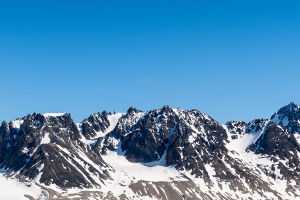The article below discusses the impact of global warming on Greenland, an island located within the Arctic Circle.
With a population of only 56,000 Inuit and Danes, Greenland is known as the world's "second coldest" place after Antarctica, where there is no rain throughout the year, and the average temperature is only -7°C.
However, in recent years, the island has experienced unusually high temperatures, leading to drastic changes in its environment.
Greenland's harsh climate has made it difficult for people to live there. The residents of the island wear warm clothes and hats all year round, but in recent days, they have been seen wearing short sleeves and shorts on the streets.
Such high temperatures are rare for this region, and they have turned this "second coldest" place in the world upside down.
Greenland is predominantly covered by ice, with a total area of 1,833,900 square kilometers, making it the second-largest ice cap in the world. This ice sheet has been losing nearly 4 trillion tons of ice from 1992 to 2018, leading to a rise in global sea levels by about 10.6 millimeters.
This melting of the ice caps is not only affecting the lives of the inhabitants of Greenland, but it is also having a significant impact on the planet as a whole.
The decline of oxygen levels in the oceans is another issue caused by global warming. The warming and acidification of the water are causing changes in the biological, chemical, and physical balance of the oceans.
These phenomena could signal a sudden and irreversible change in the Earth's systems, marking a state of emergency for the planet. Scientists warn that the melting of the Antarctic ice sheet and the decline of the Amazon rainforest have led to a tipping point that may be earlier than expected.
In a report published in the journal Nature, researchers predict that the total melting of the Greenland ice sheet is close to the highest level of global warming predicted by the United Nations Intergovernmental Panel on Climate Change (IPCC).
The study predicts that the inevitable melting of the Greenland ice sheet will lead to a sea-level rise of 27cm, which is more than twice as high as scientists had previously predicted.
The same study shows that a maximum sea-level rise of 78 cm could occur, compared to the United Nations Intergovernmental Panel on Climate Change's prediction of a 6 to 13 centimeter rise by 2100.
The researchers looked at the equilibrium of Greenland glaciers in this study. In perfect equilibrium, snowfall from Greenland's mountains flows downward, re-freezing and thickening the sides of the glacier, balancing out the melting at the edges.
However, in recent decades, less recharge and more melting have created an imbalance. The researchers calculated that Greenland glaciers would melt at least 3.3 percent regardless of global reductions.
The melting of the ice caps in Greenland is a critical issue that needs to be addressed immediately. The world needs to take action to reduce global emissions, and governments need to invest in renewable energy sources. Individuals can also make a difference by reducing their carbon footprint, using public transport, and consuming less energy.
We must work together to protect the environment and ensure a sustainable future for generations to come. The time to act is now before it is too late.
The impact of global warming on Greenland is severe, and urgent action is needed to prevent further damage to the environment. The melting of the ice caps has led to a rise in sea levels, which could have catastrophic consequences for coastal regions worldwide.
The decline of oxygen levels in the oceans is also a significant issue that needs to be addressed. We must take responsibility for our actions and work together to mitigate the impact of climate change.


